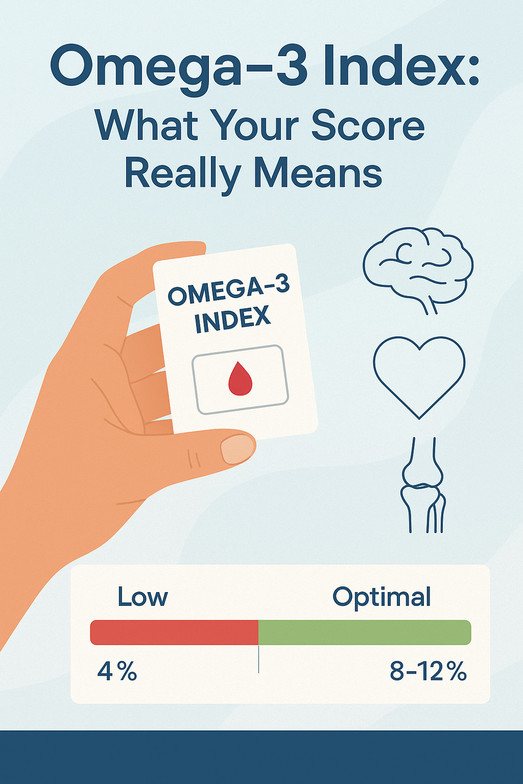
When I first heard about the Omega-3 Index test, I assumed I’d score well. I eat a balanced diet, stay active, and I’ve taken fish oil in the past. But when I finally tested myself, my number came back at 4.9%—far below the optimal target of 8% or higher.
That’s when I realized: even people who think they’re doing everything right can be deficient in these essential fats. And it might be affecting your pain, mood, inflammation, and recovery more than you realize.
What is the Omega-3 Index?
The Omega-3 Index is a simple blood test that measures the amount of EPA and DHA—two essential Omega-3 fatty acids—in your red blood cell membranes. These fats are critical for:
-
Reducing inflammation
-
Supporting brain health and mood
-
Improving heart and metabolic health
-
Helping joints, discs, and muscles recover faster
Studies show that an Omega-3 Index of 8–12% is associated with lower risk of chronic disease, while levels under 4% are considered high risk.
What the Research Says
Here’s what science tells us about Omega-3s:
-
Pain & Inflammation: Omega-3s help resolve inflammation and reduce symptoms in conditions like arthritis and chronic low back pain. (Calder, 2010)
-
Mental Health: EPA-dominant omega-3s (like those found in quality supplements) have been shown to reduce symptoms of depression and support focus in ADHD—especially when inflammation is a factor. (Guu et al., 2019)
-
Heart & Brain Health: Higher Omega-3 Index scores are associated with lower risk of heart disease, stroke, and age-related cognitive decline. (Harris et al., 2004)
What About Plant-Based Omega-3s?
Some clients ask if foods like flaxseed, chia seeds, or walnuts are enough to raise Omega-3 levels. These foods contain ALA, a plant-based omega-3—but here’s the catch:
Your body must convert ALA into EPA and DHA
That conversion is extremely limited—typically less than 10% for EPA and less than 1% for DHA
So while flax and walnuts are great for overall health, they likely won’t raise your Omega-3 Index enough on their own.
How to Improve Your Omega-3 Index
If you want to feel your best, reduce inflammation, and support long-term health, here’s what you can do now:
1. Get Tested
The only way to know your Omega-3 level is to measure it. This month, we’re offering:
-
FREE testing for members
-
$30 for non-members (normally $49)
It’s a simple finger-prick test and takes just a few minutes. You’ll get your results in 7–10 days, along with a personalized action plan.
2. Eat More Fatty Fish
Try to include 2–3 servings of cold-water fatty fish per week, such as:
-
Wild salmon
-
Sardines
-
Mackerel
-
Anchovies
-
Herring
3. Supplement Wisely
If you don’t eat fish regularly, high-quality omega-3 supplements are a smart choice. We carry trusted products like:
-
Yoli Omega-3 (available in our studio)
-
Innate Choice Omega Sufficiency + Vitamin D – a liquid form I personally like
Look for a product with at least 1,000 mg combined EPA + DHA per serving. EPA-dominant blends are particularly beneficial for inflammation and mood support.
Final Thought: Don’t Guess—Test
I was surprised by my own Omega-3 score. It reminded me how easy it is to assume we’re getting what we need—until we measure it. I’ve since resumed regular supplementation and plan to retest in a few months to track my progress.
If you’re curious about your levels, or want to optimize your energy, recovery, and brain health, come get tested. It’s one of the simplest, most impactful health checks you can do.
Stop by Atomic Pilates & Chiropractic or call us to schedule your Omega-3 Index test today.

Ryan Griffeth
Contact Me



.png)
